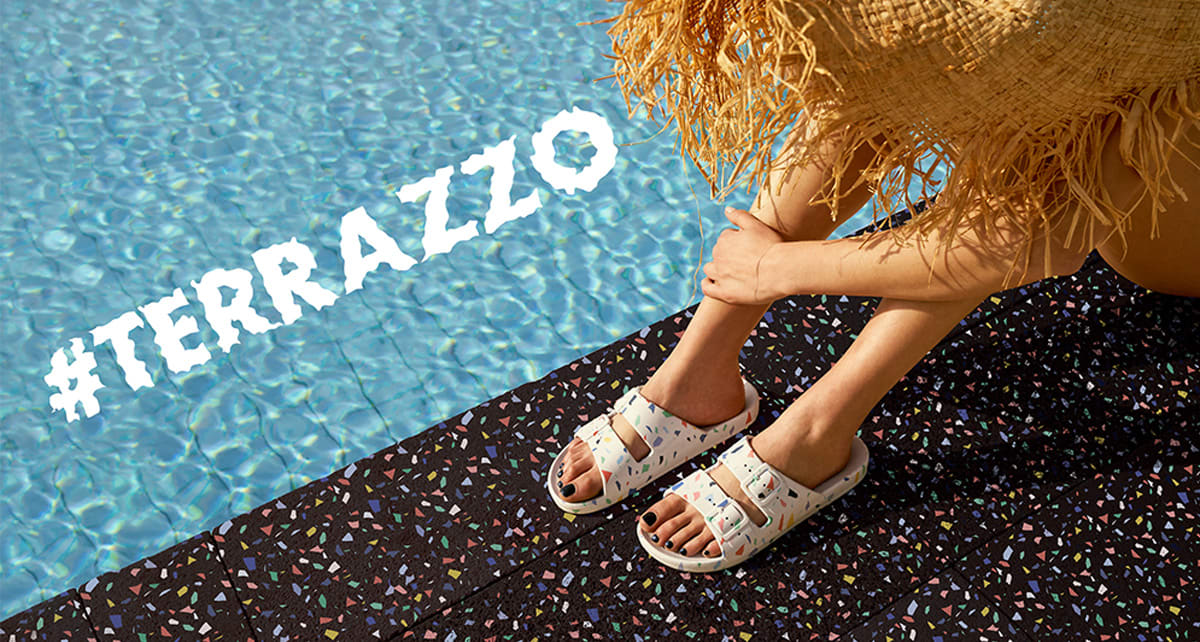Your Cart is Empty
-
FREE SHIPPING OVER $99
In January 2019, Vogue reported that terrazzo was officially making a comeback. Within just 2 years, delicate and unique terrazzo-inspired products have made their way into every aspect of our lives. And just like that, a trend that was incredibly popular in the 1970s was suddenly everywhere.
This included tile sales going up by over 50%, sparkling kitchen counters on the front page of Elle Decoration, terrazzo furniture by Urban Outfitters and décor accents like printed designs on cloth napkins by Crate and Barrel.
Going into 2022, terrazzo is still the star of the Store Decor category of Pinterest Predicts, giving a modern-vintage twist to store fronts and homes.
As for fashion, the speckled pattern had already begun making its way into our wardrobes back in 2017. The fact that it’s still a major trend today shows that although it didn’t start with fashion, it definitely belongs on the catwalk – and on our feet.
Come for the clothes, stay for the experience
The marriage of fashion and interior design is one of our favorite love stories.
We have already seen fashion brands from Gucci to River Island selling homeware and art alongside fashion. Now we’re seeing a consumer demand for lifestyle shopping experiences, where people come in to buy clothes and come out inspired in all areas of their lives.
Terrazzo fits perfectly with this new consumer passion. The terrazzo aesthetic is not only bespoke and beautifully made, but also has a little bit of everything in it, from architecture to home decor to art.
That’s why wearing a terrazzo piece like a Freedom Moses Terrazzo White slide has a certain depth to it. You’re not just wearing a beautiful slide sprinkled with colorful accents. You’re paying tribute to one of the oldest, most special trends in the world.

How old is terrazzo, really?
The idea of terrazzo flooring dates back to 15th century Venice, where construction workers could be seen rescuing scrap marble fragments to reuse in designing their own homes.
The name ‘terrazzo’ comes from ‘terrace’ in Italian to indicate the method by which leftover marble, glass or granite pieces were placed next to each other with a clay mortar base to build inexpensive terraces - each beautiful and impossible to replicate.
Jump forward to the early 20th century, terrazzo became a popular flooring material. This was thanks to the invention of electric grinding machines and material advancements like epoxy that helped make terrazzo more affordable and easier to implement.
The 1920s Art Deco style further popularized the trend in design and architecture. This continued all the way to the 1960s. The Hollywood Walk of Fame is still one of the most recognizable places where this style of floor was first installed.
And if you don’t mind digging a little deeper, the first semblance of what archaeologists call terrazzo actually dates to somewhere around 9,000 BCE. Just imagine a Neolithic Greek mason crafting the clay floor of his humble home and embedding it with crushed limestone. Now that’s a trend worthy of its status.

Welcome back, vibrancy
There’s no nice way to say it: The architecture, interior design and fashion world was practically obsessed with modern and restrained design from around the 1960s and up until a few years ago – yet another reason to appreciate hippie counterculture.
Now the Danish Modern, Eames classics and corporate modernism are making way for a renewed appreciation of the vibrant side of life. Terrazzo perfectly embodies this with texture, color and a kind of elegant shabbiness that simply says ‘I’m free to do and wear what I want’.
Make terrazzo yours
What we personally love about terrazzo design is how easily it lends itself to a freewheeling creation process.
The possibilities with this style are limitless. It’s like a playground where you can experiment with speckling, dotting, pattering, textures, asymmetry, imperfection, contrast, vibrant and neutral colors, shapes, geometric lines and curves, and above all versatility.
The beauty of this material is that it goes with everything and works with any color palette, which means you can easily make it your own.

